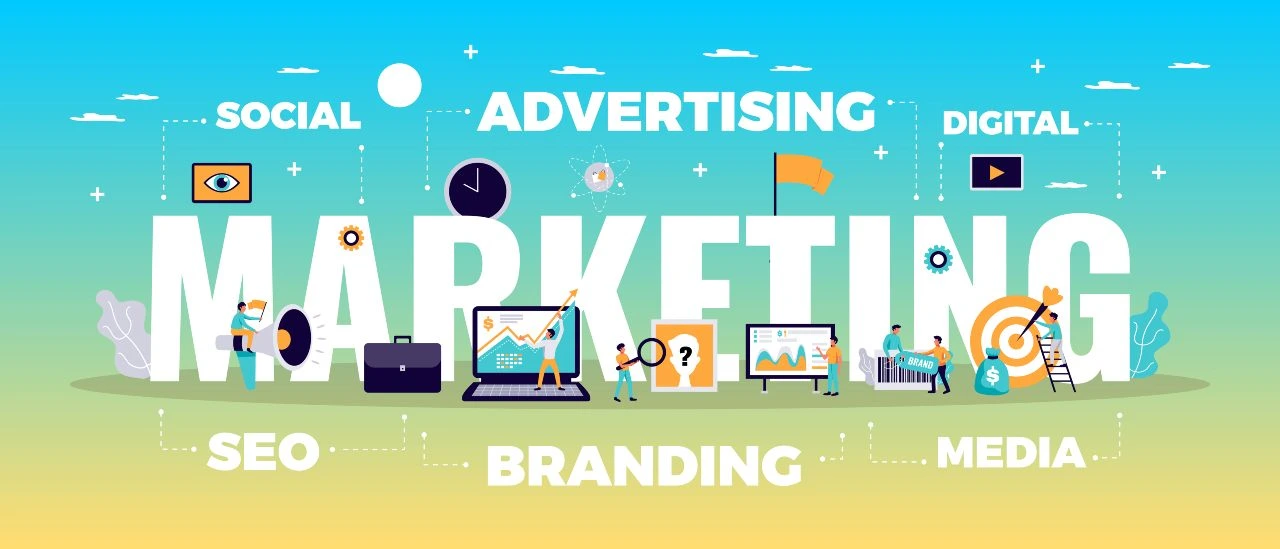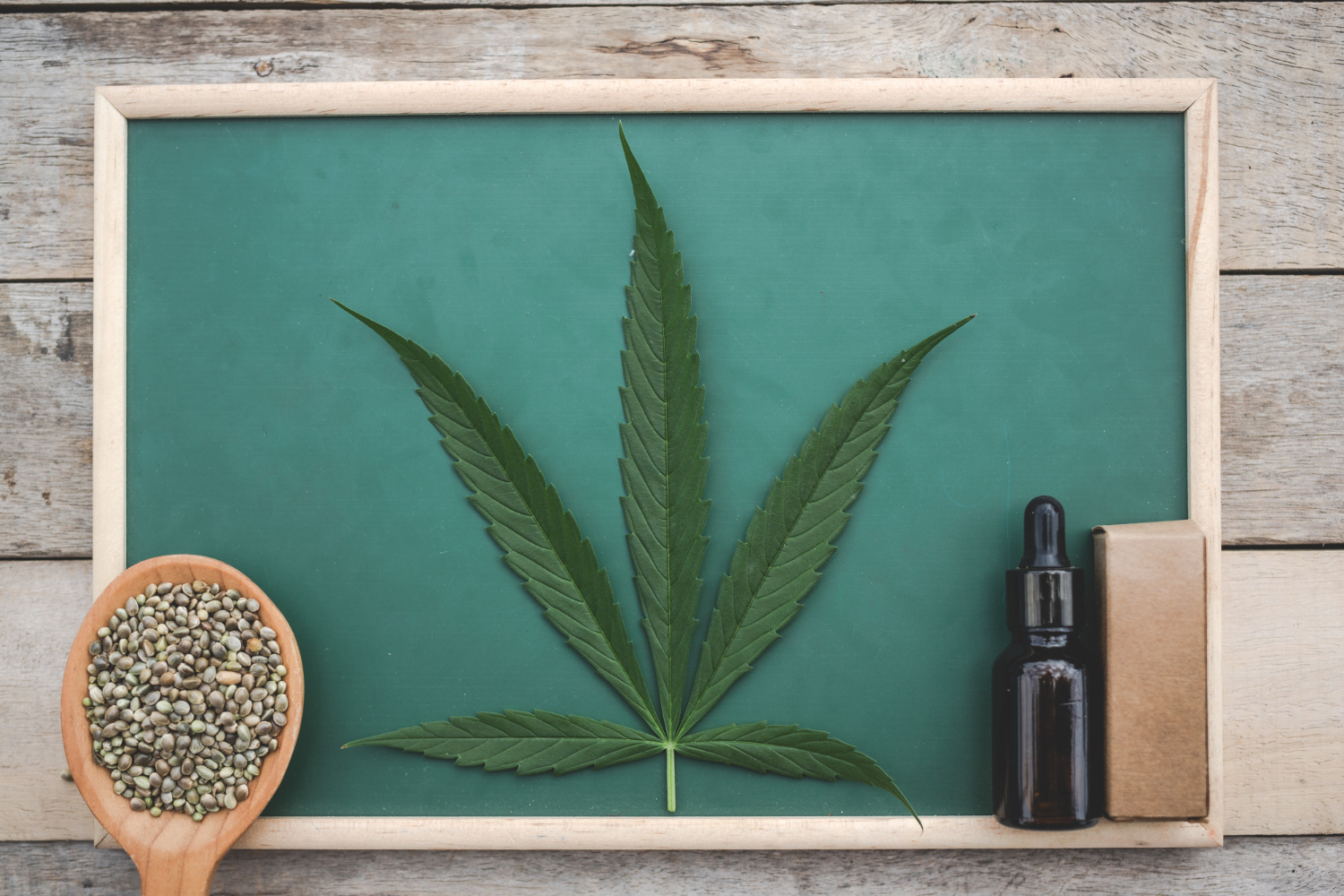As we navigate an increasingly visual world, understanding the latest video marketing trends and statistics is no longer optional—it’s essential. Video has cemented itself as a marketing mainstay, experiencing continuous evolution and explosive growth that demands our attention. But with algorithms changing, platforms emerging and disappearing (RIP Vine), and consumer attention spans dwindling, are you really getting the most out of your efforts?
From the growing influence of AI on video creation to the reign of short-form content on social media, the video marketing landscape is dynamic. With projections pointing towards even greater video consumption, now is the time to explore the trends shaping video marketing.
In this article, we’ll share the data-driven insights you need to optimize your video strategies, connect authentically with your audience, and stay ahead of the curve in 2025.
Role of AI in Shaping Video Marketing’s Future
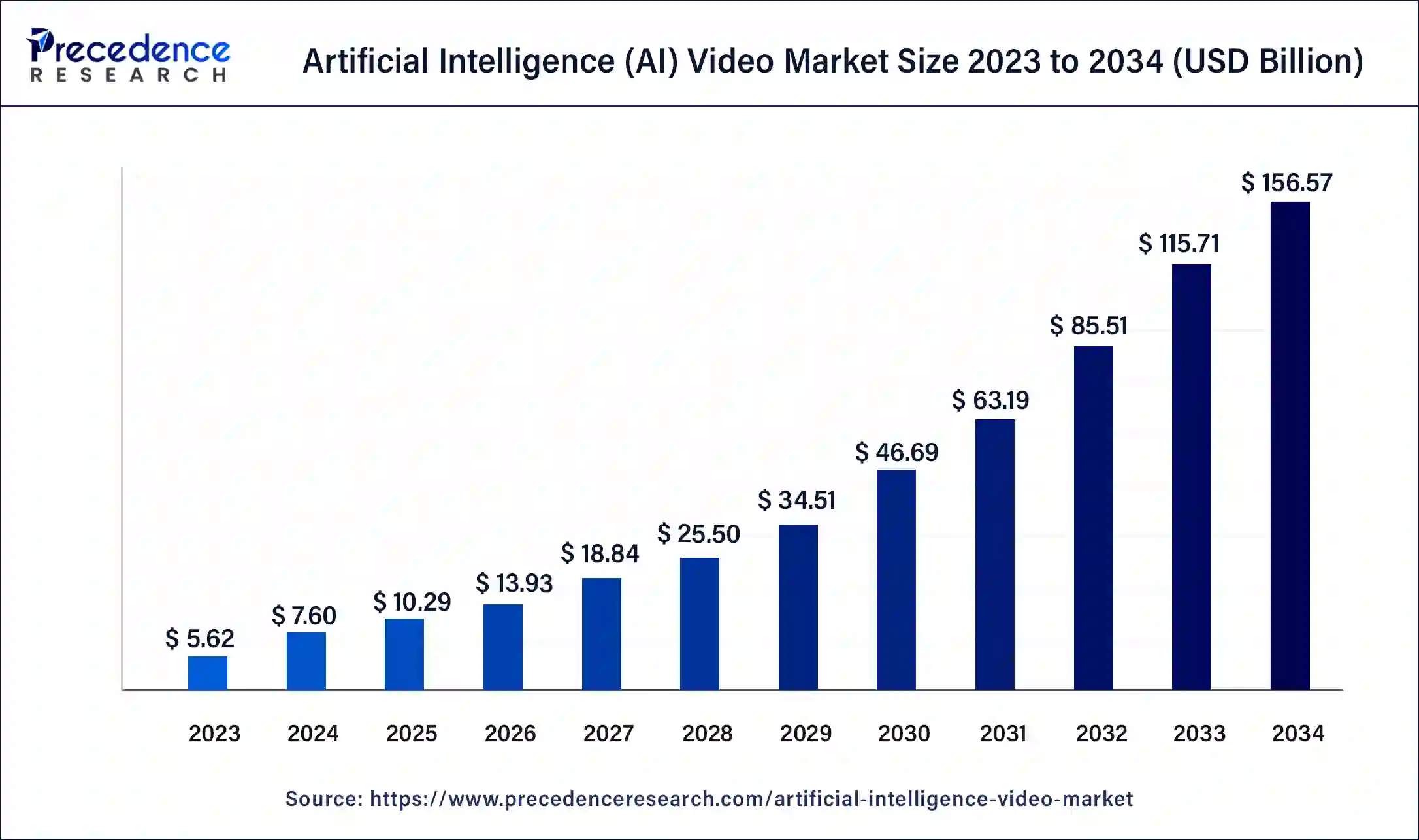
Source: Precedence Research
Artificial intelligence is no longer just a buzzword—it’s a core driver of innovation in video marketing. From automating time-intensive tasks to delivering precise audience insights, AI is enabling marketers to scale their efforts without sacrificing quality. With the increasing demand for fresh, engaging video content, AI’s ability to enhance productivity and creativity is rapidly becoming a game-changer in the industry. Here are some compelling statistics that showcase how AI is reshaping video marketing:
- In 2024, 84% of video marketers reported using AI in some capacity during the video production process. Source
- A stunning 96% of marketers believe AI will play a pivotal role in shaping future marketing strategies, up significantly from 2023, reflecting the rising confidence in AI’s potential. Source
- Thanks to AI-driven production efficiencies, 74% of marketers now produce between two and six videos monthly for multi-platform distribution, marking a steady increase from the prior year. Source
Key Takeaway
AI is more than a tool—it’s a strategic ally in video marketing. By alleviating manual production bottlenecks and empowering marketers with advanced insights, it’s not just improving workflows, but also elevating the quality of content being delivered. As consumer expectations continue to evolve, businesses that embrace AI-driven solutions are better positioned to create faster, smarter, and more dynamic video strategies that engage audiences and drive results.
Pro Tip:
Start small with AI by integrating tools that automate repetitive tasks, such as video editing or subtitle generation. Once you see the impact, consider scaling up with AI-based analytics platforms to uncover audience behaviors and preferences. Leveraging the right combination of AI technologies can turn your video marketing strategy into a competitive advantage.
How AI is Revolutionizing Video Marketing with Personalization and Efficiency
The integration of artificial intelligence (AI) into video marketing is no longer just an innovation—it’s quickly becoming a competitive necessity. With consumer demand for personalized content at an all-time high, AI provides marketers with powerful tools to not only meet but exceed audience expectations. Whether it’s automating time-intensive tasks like editing or creating hyper-targeted content, AI is reshaping how brands produce and deliver video content at scale. By seamlessly blending creativity with technology, businesses can now drive deeper engagement while maximizing the efficiency of their video strategies.
- AI-powered advertising is empowering marketers to create smarter, data-driven video ads that achieve higher ROI. Source
- Generative AI tools—like Sora—are redefining content creation by transforming text-based ideas into fully realized, engaging video content. Source
- AI platforms simplify every stage of video creation, from brainstorming topics and drafting scripts to editing and repurposing content for multiple social media platforms. Source
- Advanced AI-powered video editing tools streamline scripting and post-production, enabling brands to create professional-quality videos even with limited budgets. Source
- Dynamic AI personalization allows video ads to adapt in real time to individual viewer preferences based on their interests, behaviors, and demographic data, leading to superior audience engagement. Source
- AI Video Cut facilitates automated captioning with precise synchronization and customization options for different audiences and platforms. Source
- The same platform, AI Video Cut, optimizes video for multiple platforms by creating tailored versions with appropriate aspect ratios and audience-specific content. Source
Key Takeaway
The convergence of AI and video marketing is paving the way for a more streamlined and innovative approach to content creation. Beyond saving time and resources, the ability to craft truly personalized and platform-optimized videos sets brands apart in a crowded digital landscape. With advancements like AI-driven personalization and generative tools, brands can create videos that not only resonate with their audience but also align perfectly with their behaviors and preferences. Embracing AI is not just an efficiency play—it’s a leap toward more meaningful and impactful storytelling in video marketing.
Pro Tip:
To fully harness the potential of AI in video marketing, invest time in exploring automation tools that fit your unique needs. Start small by experimenting with AI-powered captioning and editing platforms, then scale up to using generative AI for full-fledged video production. These tools not only enhance content creation but also provide valuable analytics to refine your video strategies continually.
Role of AI in Revolutionizing Video Marketing Campaigns
AI is no longer just a buzzword; it’s a game-changer in the marketing landscape, reshaping how brands strategize, execute, and refine their video campaigns. In a competitive digital world where efficiency and personalization are paramount, AI-powered technologies are empowering marketers to elevate their efforts by automating repetitive tasks, analyzing complex data, and enhancing creative workflows. From editing to optimization, AI is the secret weapon behind today’s most successful video strategies.
- AI and machine learning (ML) streamline repetitive processes, enabling automated email marketing campaigns based on customer behavior or real-time bidding for ad placements. Source
- With the ability to adapt in real-time, AI tools use ML algorithms to analyze performance data and continuously refine campaign strategies for better outcomes. Source
- AI is transforming video editing workflows, providing automated tools that reduce manual effort and accelerate the editing process—freeing up marketers to focus on strategy and storytelling. Source
Key Takeaway
As video becomes indispensable to marketing strategies, AI ensures campaigns are not only impactful but also efficient. The ability to automate tasks, optimize campaigns dynamically, and speed up workflows through advanced tools gives marketers time to focus on creativity and customer connection. By harnessing AI, brands can stay ahead of the curve, delivering personalized and high-quality video content at scale—without compromising on impact.
Pro Tip:
Experiment with AI-powered video tools like Pictory or Synthesia to create dynamic, personalized content faster. Use analytics-driven insights from platforms like Vidyard or Wistia to refine your strategy in real-time and ensure your videos truly resonate with your audience.
For businesses looking to integrate AI-powered video marketing into a broader, cohesive strategy, adopting full-service marketing solutions can be a game-changer. By combining video, SEO, email marketing, and more into a unified approach, brands can maximize their digital presence while staying ahead of industry trends.
Redefining How Consumers Engage with Video Content
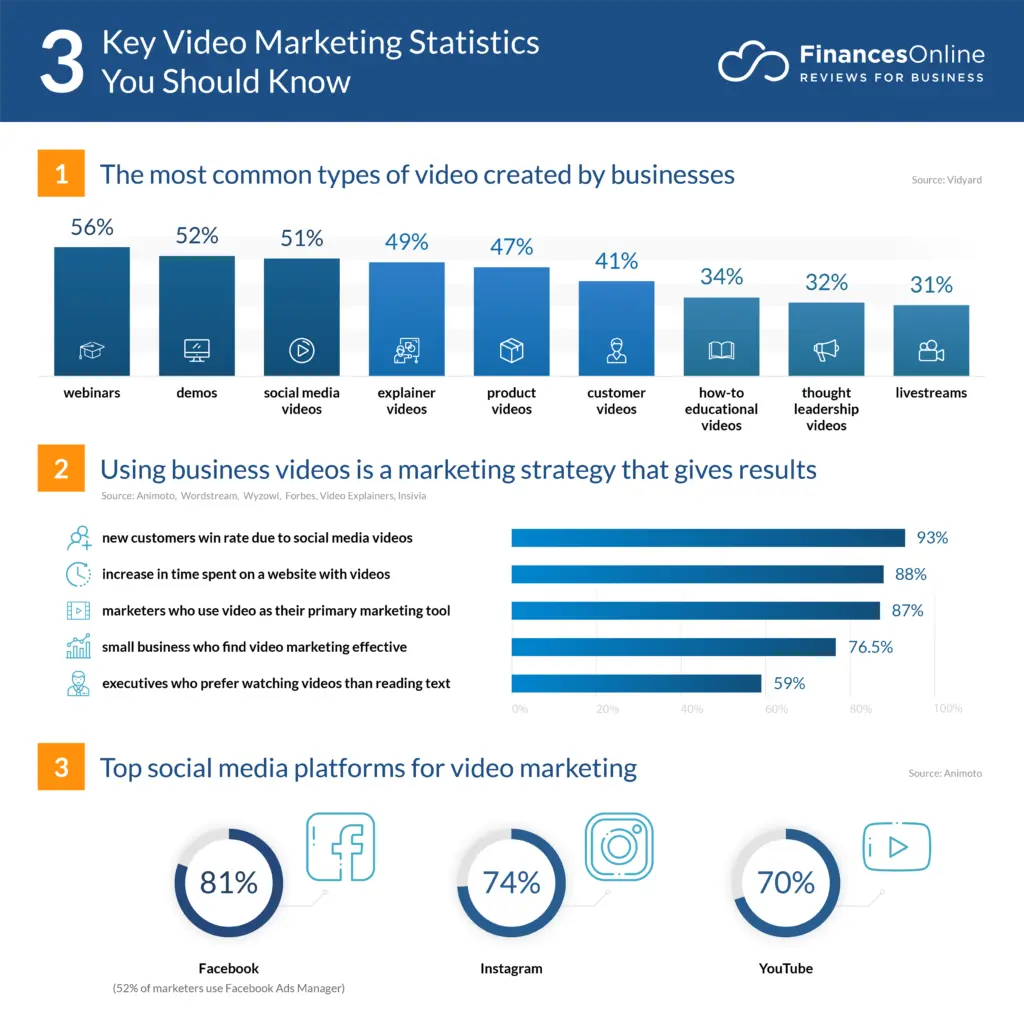
Source: FinanceOnline
The way consumers interact with video content is evolving rapidly, and brands that understand these preferences hold the key to forging deeper connections with their audiences. Video isn’t just about entertaining—it’s become a primary method for educating, engaging, and influencing purchasing decisions. From short-form tutorials to binge-worthy streaming platforms, video is now woven into the fabric of daily life, and the numbers confirm just how vital it is for marketers.
- Five major streaming apps—Amazon Video, Disney+, Hulu, Netflix, and YouTube—dominate the connected TV landscape, accounting for an impressive 80% of all connected TV viewing. Source
- By 2022, Cisco projected that online videos would constitute over 82% of consumer internet traffic, emphasizing the growing shift toward video-first experiences. Source
- Short videos resonate with audiences: 69% of individuals prefer to learn about products or services through short-form video. Source
- A remarkable 85% of consumers express a desire to see more video content from brands, showcasing the appetite for visual storytelling. SourSourcee
- Video consumption is a daily ritual for many, with 78% of people watching online videos weekly and 55% tuning in every single day. Source
- Smartphones lead the charge in video consumption, with 62% of consumers preferring to watch videos on their mobile devices. Source
- Laptops take second place as the preferred device for video viewing, with 18% of audiences opting for this format. Source
- Video content from brands is highly appreciated, with 81% of respondents in 2024 indicating they enjoy these videos either “very much” or “somewhat.” Meanwhile, only 2% say they don’t enjoy branded video content at all. Source
Key Takeaway
The dominance of video as the preferred medium for learning, entertainment, and brand engagement highlights a clear opportunity for marketing teams. With smartphones emerging as the top device for video consumption, brands must prioritize creating mobile-first video strategies. This means incorporating vertical and short-form formats, ensuring fast loading times, and delivering content that captivates smaller, portable screens.
Additionally, the demand for short and engaging videos underscores the importance of storytelling in micro-moments—capturing attention quickly and delivering meaningful value in bite-sized content. Whether it’s an explainer video or a product teaser, meeting these expectations will position brands as leaders in the ever-competitive digital space.
Pro Tip:
Focus your efforts on the platforms and devices your audience prefers. Optimize your video content for mobile-friendly formats, leverage social media algorithms that favor video, and experiment with tools like Instagram Reels, YouTube Shorts, or TikTok to align with current consumption trends. The more accessible, relevant, and shareable your content, the greater its impact will be.
Why Educational and Product-Focused Videos Are Winning Hearts (and Clicks)
Video marketing isn’t just about entertainment anymore—it’s about empowering audiences to make smarter decisions. Businesses are shifting toward educational and product-focused videos as a means to build trust, offer value, and meet the growing demand for digestible, informative content. In an age where attention spans are thinning, these formats deliver clarity and impact, helping brands stand out in a crowded marketplace.
- Educational videos topped the charts in 2023, accounting for 47% of all videos created by businesses. Source
- Nearly half (47%) of companies use videos like tutorials, how-to guides, and explainer content to teach their audience something valuable. Source
- Product-related videos, focused on showcasing features and benefits, were the second most popular video type, comprising 33% of business video content. Source
Key Takeaway
Educational and product-focused videos don’t just inform—they convert. Today’s consumers are looking for brands that make their lives easier by offering clear, actionable insights. Product demonstrations, tutorials, and thought leadership videos can position your business as a problem-solver. More importantly, these videos build credibility and deepen connection by educating without overtly selling. When done right, they bridge the gap between curiosity and purchase.
Pro Tip:
To amplify the impact of your educational and product videos, focus on storytelling. Show your audience how your product solves real-world problems or teach them something that enhances their daily work or life. Pair this with thoughtful production quality—clear visuals, crisp audio, and concise messaging—for a professional finish that leaves a lasting impression.
How Short-Form Videos Are Reshaping Social Media Marketing
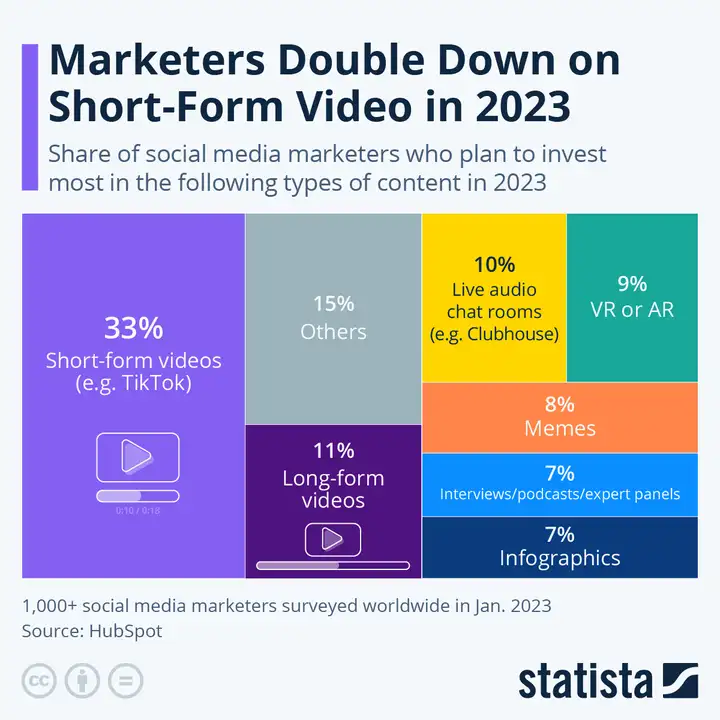
Source: Statista
Short-form videos have completely transformed social media marketing, offering brands an unparalleled way to engage users in just a matter of seconds. With the rise of platforms like Instagram Reels and TikTok, these bite-sized videos have become the go-to format for delivering relatable, scroll-stopping content. Their success lies in a simple yet powerful equation: quick, impactful storytelling combined with a focus on authenticity that resonates with modern audiences.
- Social media platforms have fully embraced video features. Source
- Platforms like Instagram and TikTok are now dominated by short-form videos. Source
- Creating videos for social media channels offers a significant opportunity to reach your target audience. Source
- Authenticity and addressing audience needs are key to successful low-budget video marketing. Source
Key Takeway
The rise of short-form video isn’t just a trend—it’s a shift in content consumption habits that brands can’t afford to ignore. What makes it revolutionary is how easily it levels the playing field, allowing startups and small businesses to compete with larger brands without massive production budgets. By prioritizing authenticity, storytelling, and audience-focused content, marketers can forge genuine connections and drive engagement more effectively than ever.
Pro Tip:
Don’t sacrifice relevance for perfection. A simple behind-the-scenes clip or a quick tip shot on your smartphone can often outperform highly produced content. For a consistent strategy, align your short-form videos with trending topics and audience interests specific to each platform, ensuring every piece feels personal and timely.
Harnessing Viewer Insights to Shape Winning Video Strategies
The secret to impactful video marketing lies in understanding your audience better than ever before. By diving into the data behind viewer behavior, marketers can uncover what truly resonates, identify content gaps, and refine their strategies to maximize returns. From click-through rates to engagement durations, every metric offers a roadmap to crafting content that captivates and converts.
- Data-driven strategies empower marketers to align their video content with viewer preferences and behaviors. Source
- Metrics like engagement times and click-through rates reveal actionable insights to fine-tune creative direction. Source
Adopting a data-first mindset transforms the way brands approach video creation and distribution. Instead of relying on assumptions, the ability to analyze real viewer behavior ensures every piece of content is more relevant, engaging, and optimized for performance.
Pro Tip:
Don’t just collect data—act on it. Use tools like Google Analytics, YouTube’s built-in analytics, or third-party platforms to track performance metrics. Then, experiment with A/B testing on thumbnails, video lengths, and even posting times to understand what resonates best with your audience.
For businesses looking to amplify their results, combining video insights with broader digital marketing strategies for small businesses can provide a comprehensive approach to driving engagement and growth. By integrating video with other marketing channels, brands can create a cohesive strategy that resonates across platforms.
Why B2B Brands Are Embracing Video Marketing Like Never Before
In the fast-paced world of B2B, where decision-making often involves multiple stakeholders and lengthy sales cycles, video marketing has emerged as a game-changer. The ability to simplify complex ideas, humanize brands, and create engaging customer experiences makes video the ideal medium for educating and converting busy professionals. But more than just a tool for engagement, video serves as a catalyst for driving measurable business outcomes—from sign-ups to demo requests.
- B2B video marketing can achieve conversion rates of approximately 4.8%, including actions like newsletter sign-ups, whitepaper downloads, or product demo requests. Source
- Videos are proven to enhance user understanding of products or services, driving organic traffic to landing pages and significantly boosting website visits. Source
- Video ads are becoming a staple in B2B campaigns, offering a highly effective way to communicate intricate information while keeping audiences engaged on platforms like YouTube. Source
- Explainer videos are particularly influential in B2B, building trust, credibility, and thought leadership while improving brand visibility and conversion rates. Source
- By simplifying complex ideas, explainer videos help marketers effectively reach audiences, making them a cornerstone of successful B2B campaigns. Source
Key Takeaway
One of the key trends in B2B sales is the rise of video marketing, which speaks to its ability to address both educational and emotional needs. It’s not just about delivering information—great video content builds trust, clarifies value propositions, and nudges potential clients closer to action. In a competitive B2B space, your video strategy should focus on blending technical clarity with storytelling that resonates with your audience.
Pro Tip:
To maximize the impact of your video marketing efforts, experiment with content tailored to different stages of the buyer’s journey. For example, use explainer videos in the awareness stage, customer testimonials during consideration, and product demos to seal the deal in the decision phase. Tools like Vidyard, Wistia, and Vimeo can help you create professional, impactful videos that drive results.
Amplifying Trust Through User-Generated Video Content
As video continues to dominate the marketing landscape, one trend is crystal clear for 2025: audiences crave authenticity. The polished, overly-produced brand videos of yesteryear are losing their sheen, and in their place, user-generated content (UGC) is thriving. Why? Because it offers a raw, relatable perspective that builds trust while simultaneously providing organic social proof. In a world where consumers value genuine connections over hard-sell tactics, UGC could be your secret weapon for breaking through the noise.
- UGC videos resonate deeply with audiences, as they are viewed as more authentic and relatable, fostering trust in your brand and inspiring community participation. Source
- When customers create and share videos about your brand, it acts as social proof, reinforcing credibility and encouraging others to engage with your products or services. Source
Key Takeaway
Investing in UGC is more than a marketing tactic; it’s a way to turn your customers into brand advocates. By encouraging your audience to share their stories, reviews, or creative takes on your products in video form, you’re not just creating content—you’re creating a community. Launch interactive challenges, incentivize contributions, or simply celebrate your customers’ content to create a feedback loop of engagement and trust.
Pro Tip:
To make UGC even more impactful, showcase user-submitted videos on multiple platforms—your website, social media, and even email campaigns. Highlighting these contributions doesn’t just amplify your marketing efforts; it validates and rewards your audience’s role in your brand story.
Mastering Video Success with Data-Driven Insights
In 2025, video marketing success will hinge on leveraging analytics and attribution to their full potential. As competition intensifies and consumers demand more personalized and meaningful experiences, brands that can effectively measure their video performance across the buyer journey will stand apart. Understanding not just what works but why it works allows marketers to allocate budgets more wisely and create content that resonates with their audience at every stage.
- By 2025, precise attribution will be crucial to identify which marketing efforts directly drive conversions, enabling smarter resource allocation. Source
- Regularly monitoring video performance analytics will help uncover what resonates with your audience, guiding ongoing optimization of your video strategy. Source
Pro Tip:
Don’t just stop at basic metrics like views or clicks; dive deeper into advanced KPIs such as engagement rates, viewer drop-off points, and conversion events. These insights will help you uncover hidden opportunities for optimization, ensuring your video content consistently delivers ROI.
Conclusion
The trajectory of video in marketing statistics paints a compelling picture: video is not just a communication tool, but the cornerstone of modern marketing strategies. With AI driving efficiency, personalization, and cost-effectiveness, video production is becoming more powerful and accessible than ever before. Marketers now have the opportunity to create hyper-targeted, meaningful content that resonates with audiences across platforms, from short-form social media videos to in-depth educational content.
While the rise of user-generated content and the demand for authenticity redefine how brands build trust, analytics and data-driven insights are fine-tuning how campaigns are optimized for success. For marketers, embracing these trends means not only staying relevant but also harnessing the untapped potential of video to drive engagement, loyalty, and ROI.
Ready to boost your traffic and grow your website? Your customers are looking for you, and our SEO services can help you be found across search engines. Let’s create a strategy that ensures your video content—and your business—leads the conversation in 2025 and beyond.
About What 2025 Holds for Video Marketing Statistics
This guide was written by the Scopic Studios team and reviewed by Araksya Hakobjanyan, SEO Lead at Scopic Studios.
Scopic Studios delivers exceptional and engaging content rooted in our expertise across marketing and creative services. Our team of talented writers and digital experts excel in transforming intricate concepts into captivating narratives tailored for diverse industries. We’re passionate about crafting content that not only resonates but also drives value across all digital platforms.
Note: This feature blog’s image are sourced from Freepik.





















































































































































































































